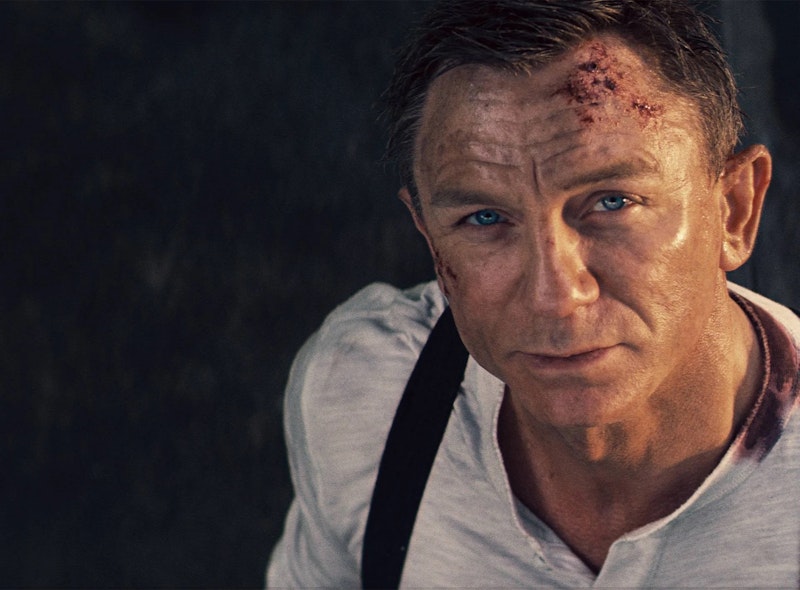It’s bleak irony that a film titled No Time to Die was scheduled to open in April 2020. Eon Productions’ 25th James Bond movie, it became the first major film to have its opening delayed due to Covid, finally premiering in late September of 2021. Daniel Craig had revealed this would be his last turn as James Bond; all the dangling plot threads of the past few movies were to be resolved here, all the character arcs tied up. And so it proves, even if the movie takes two and three-quarter hours to do it.
It opens with a traumatic incident in the childhood of Bond’s current love, Madeleine Swann (Léa Seydoux), and then returns to the present and an explosion at the tomb of Bond’s previous love, Vesper Lynd, which Bond’s visiting. Bond fights agents from the sinister organization Spectre but (improbably) comes to believe they were working with Swann, and breaks off their relationship.
Five years later Spectre agents steal a nanobot bioweapon codenamed Project Hercules. A couple of CIA guys, Bond’s old buddy Felix Leiter (Jeffrey Wright) and new chap Logan Ash (Billy Magnussen), want the now-retired Bond to track it down. After MI6 warns him not to agree, he does, and is sent to a party in Cuba where the agents of the supersecret society are gathering. Assorted double-crosses follow; Leiter ends up dead, Bond learns Blofeld’s manipulating events from prison, and the sinister Lyutsifer Safin (Rami Malek) is introduced.
Bond goes to interrogate Blofeld, but finds he only talks to his psychiatrist, Swann. As Blofeld had previously kidnaped Swann and threatened to kill her, it’s an implausible relationship, but convenient to the plot. Less clear is why Bond didn’t turn Swann in for (he believes) working with Spectre. Assorted fiddling-about with nanobots happens, Bond learns Blofeld (from prison) was responsible for the bombing that wrecked his relationship five years ago, and Blofeld ends up dead.
MI6 can’t prevent Swann from leaving England and returning to her childhood home in Norway, Bond tracks her there, and finds Swann has a five-year-old daughter. An infodump about the real villain of the movie, Safin, follows. Logan Ash shows up and there’s a firefight. Safin abducts Swann and her daughter, and MI6 equips Bond to go after them to Safin’s base in the Sea of Japan, where Safin has a garden of lethal poisons. In the third act there’s an unusual amount of closure for a James Bond story, ending the five-film arc.
The movie’s directed by Cary Joji Fukunaga, who gets solid performances but allows some sequences to go on too long. Running time aside, the pacing’s inconsistent. Neal Purvis and Robert Wade return as writers for the seventh straight film, with contributions to the script also coming from Fukunaga and Phoebe Waller-Bridge. Waller-Bridge is the first woman credited with script work on a Bond movie since From Russia With Love, but also worth noting is that for the first time in a long while a Bond film adapts ideas from Ian Fleming—the poison garden of Safin’s base is taken directly from the novel You Only Live Twice.
The movie weirdly reflects the metaplot it wraps up. In both this film and the larger five-film story, the narrative arc doesn’t work because too many threads leave it too diffuse. As character studies both No Time to Die and the overarching tale have good points, thanks to Craig making strong choices. But that character work’s nowhere near important enough to either film or arc to work as character study. They’re necessarily shallow, trying to fit a serious figure into a story about magical nanotechnology and clandestine criminal organizations.
Craig’s five films are inconsistent, with too many flaws within even the stronger movies. You can see some of the flaws that haunt his whole run here, starting with an incoherent story and continuing through character relationships that make no particular sense (it’s hard to exaggerate how improbable Swann as Blofeld’s shrink is, and how little effort the film makes to justify it). I think this film’s better than the previous two, though not as good as Craig’s first two outings. But it’s both soap operatic and tedious, with a multiplicity of sub-plots—a rift between MI6 and the CIA, Bond replaced as agent 007, Madeleine Swann’s connection to Safin, and her child, and so on.
Too much is going on with too weak a through-line. The nominal villain, Safin, gets lost among the various plot threads, which isn’t helped by taking Blofeld off the board in an unconvincing assassination. A bigger problem is that the film wants to sell Safin as an evil opposite to Bond—in the same way Blofeld was, and the same way Raoul Silva in Skyfall was.
This and the previous Craig Bond movies share a serious tone that doesn’t work well with the cutting-edge technological weirdness characteristic of Bond adventure. The film ends up in a gray zone between pulp and drama, failing at both, while the nanotech plot contrivances are too magical to blend into Bond’s world.
No Time to Die ultimately does what it has to do. It wraps things up, with a genuinely unexpected ending. The meta-arc of Craig’s Bond doesn’t work, but it’s an interesting attempt to do something with the character. The better news now is that with Craig gone, that story is over, and there’s the chance to reinvent James Bond once again.

